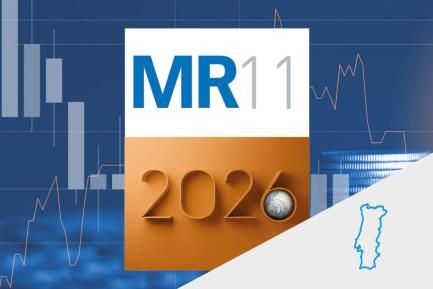Industry in Portugal: a sector in motion
• Industry, traditionally oriented towards the foreign market, is fundamental to ensuring that Portugal continues to expand its exporting activity (a major driver of growth since the financial crisis and key to the correction of external imbalances).
• The industrial sector represents 16% of Portuguese GDP, a similar figure to that of Spain, lower than that of the euro area and higher than that of France.
• Industrial activity still faces significant challenges, especially in sectors with low value added. However, there are signs of greater buoyancy in industries with more advanced production processes, which suggests a (small, yet promising) leap forward in the value creation chain.
Despite the structural shift towards a greater role of services in the economy, industry remains a key sector. As can be seen in the first chart, the industrial sector represents 16% of Portuguese GDP and 21% of the gross value added generated by non-financial corporations. Furthermore, it employs around 720,000 people, equivalent to 15% of total employment. The average company in the industrial sector is more productive too. In terms of apparent labour productivity, the value added generated by each worker in the sector is higher than the average for the economy as a whole: 31,000 euros, compared to 23,900 on average among non-financial corporations. In this article, we will focus our analysis on the sub-sector of the manufacturing industry, which represents 99% of the gross value added (GVA)1 of the industrial sector and is particularly orientated towards the foreign market.
Indeed, one of the salient features of the manufacturing industry is precisely that its production is especially geared towards the foreign market: the sector’s foreign sales and the services that it provides abroad represent 60% of all exports of goods and services carried out by the whole of the Portuguese economy (excluding tourism). Furthermore, the percentage of companies with an exporting profile2 present in the manufacturing industry (16.2%, which is equivalent to around 6,500 companies) far exceeds that of all the non-financial corporations operating in Portugal (6%). In addition, these companies with an exporting profile play a leading role in the manufacturing industry: they represent 71.9% of its turnover, 68.5% of its GVA and 53.2% of its employment. Finally, as shown in the second chart, in recent years export activity has been responsible for most of the growth in turnover in the manufacturing industry.
As for the manufacturing industry’s technological intensity, the third chart shows that Portugal is trailing far behind Germany, the country at the cutting edge, as well as being behind countries with a GDP3 per capita similar to that of Portugal. In fact, Portugal is clearly dominated by companies with a low-medium4 technological intensity, which represent slightly over 90% of the total number of firms in the manufacturing industry and generate 75% of its turnover. In addition, these segments are dominated by smaller companies.
Although companies operating in sub-sectors with a high and medium-high technological intensity represent slightly less than 10% of the manufacturing industry, they generate 25% of its turnover and account for 20% of the total investment. These figures are significant and demonstrate that these companies have the capacity to boost economic growth. Furthermore, it is particularly promising to note that in recent years there has been a rise in the creation of companies that incorporate productive processes with a high technological intensity: in cumulative terms, the number increased by 7.5% between 2012 and 2016 (while the number of firms in the manufacturing industry overall dropped by 0.4% over the same period). In addition, sectors with a higher technological intensity tend to be made up of companies that form part of multinational groups. Indeed, in Portugal, companies that form part of foreign business groups also play an important role, generating 73% of turnover in the medium-high technology sector and 65% in the high technology sector. Lastly, among medium-high technology and high technology industries, industrial activity is particularly concentrated into six sectors.5 Despite representing only 3.3% of companies in the manufacturing industry, these six sectors generate 22% of its turnover and account for around 18% of Portugal’s total exports of goods and services (excluding tourism).
Finally, we must comment on the industry’s investment rate6 and its future outlook. Although the investment rate in the manufacturing industry is still below the levels reached in 2008 (21.3% in 2017 versus 26.1% in 2008), it has recovered steadily since 2012, favoured by the improvement in the global economic environment, and i t has benefited the growth of the industrial sector. The strength of investment in R&D is another particularly positive trend. Since 2012, it has grown at an average annual rate of 16.3% and has increased its weight relative to the total investment carried out by the manufacturing industry, reaching 2.4%. This lays the foundations for the industry to commit to more innovative production models and to continue to increase its value added. These foundations are already reflected in indicators such as the World Bank’s competitiveness index. In particular, this index points out that in recent years Portugal’s industry has improved its investment in R&D, both in quantity and quality. It also reflects improvements in the dissemination of information technologies and in the level of training for workers in the industry. However, the future challenges remain significant: the World Bank’s index shows the need to achieve greater dynamism in the business sector (that is, greater flexibility in the entry and departure of companies into and from the market), as well as the need to take further steps in adopting new technologies and working methods.
Teresa Gil Pinheiro
1. Data for 2017.
2. We say that a company has an exporting profile if: 1) 50% of its turnover comes from the export of goods and services, or 2) 10% of its turnover comes from exports, but in absolute terms this exceeds 150,000 euros.
3. In purchasing power parity terms.
4. This classification is based on criteria such as expenditure on R&D, but it should not be taken at face value. For instance, there will be companies classified as having a low and medium-low technological intensity that use cutting-edge technologies in their production processes and are committed to innovation. In Portugal, the textile sector is an example of this. Examples of sectors within the low technological intensity category include: textiles and clothing (18% of GVA); food (17.5%); wood, paper pulp (10%). Medium-low intensity: manufacturing of rubber, plastic articles (11.4%); basic metallurgy (11%); repair and maintenance of machines and equipment (8%); coke and refined products (2%). Medium-high intensity: transport equipment (6%); machines and equipment (4%); chemicals and synthetic fibres (4%); electrical equipment (2.5%). High intensity: pharmaceutical products (2%); computer and communications equipment (2%).
5. The manufacture of computer, communications, electronic and optical equipment, the pharmaceutical industry, the manufacture of vehicles, the chemical industry, and the manufacture of electrical equipment.
6. i.e. the ratio between gross fixed capital formation and GVA.





